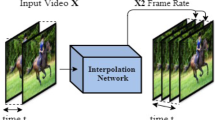Abstract
A frame interpolation algorithm for the application of low-bit-rate video coding is proposed in this paper. The global motion vectors are first estimated by computing global sum of absolute differences between frames. Then the block motion estimation is carried out according to the modified weighted correlation index criteria. The estimation is further adjusted around the moving object based on the modified weighted correlation index criteria but with a smaller factor k so that the global motion estimation is less influential to the movement vector estimation for the moving objects. Finally the motion estimation outliers are determined by the Box-and-Whisker analysis, and removed by two methods. Method 1 redoes the bi-directional estimation with a larger factor k; Method 2 computes the movement vectors of the outliers using neighboring movement vectors. The experiments showed that the proposed method can improve the peak signal to noise ratio for four test video sequences. Visual inspection also shows better frame interpolation quality.










Similar content being viewed by others
References
Bagni D, Riva V, Albani L (1999) An innovative temporal post-processing to increase the frame rate in h.263 encoding systems. IEEE International Picture Coding Symposium 273–280
Choi B-T, Lee S-H, Ko S-J (2000) New frame rate up-conversion using bi-directional motion estimation. IEEE Trans Consum Electron 46(3):603–609
Chen T, Wang Y, Graf HP, Swain C (1994) A new frame interpolation scheme for talking head sequences. Proc of IEEE Intl Conf on Image Processing 591–594
Choi B-D, Han J-W, Kim C-S, Ko S-J (2007) Motion-compensated frame interpolation using bilateral motion estimation and adaptive overlapped block motion compensation. IEEE Trans Circuit Syst Video Technol 17(4):407–416
“Draft ITU-T recommendation and final draft international standard of joint video specification (ITU-T Rec.H.264/ISO/IEC 14496-10 AVC),” in Joint Video Team (JVT) of ISO/IEC MPEG and ITU-T VCEG, JVTG050, 2003
Ha T, Lee S, Kim J (2004) Motion compensated frame interpolation by new block-based motion estimation algorithm. IEEE Trans Consum Electron 50(2):752–759
Kuo T, Jay Kuo C-C (1998) Motion-compensated interpolation for low-bit-rate video quality enhancement. Proc SPIE 3460:277–288
Thoma R, Bierling M (1989) Motion com- pensating interpolation considering covered and uncovered background. Signal Process- ing: Image Compression 1:191–212
Wong CK, Au OC et al (1996) Modified motion compensated temporal frame interpolation for very low bit rate video. IEEE International Conference on Acoustics, Speech, and Signal Processing 4:2329–2332
Author information
Authors and Affiliations
Corresponding author
Rights and permissions
About this article
Cite this article
He, S., Xing, C. & Zhao, P. Global bi-directional motion compensation frame interpolation algorithm. Multimed Tools Appl 52, 19–31 (2011). https://doi.org/10.1007/s11042-009-0450-1
Published:
Issue Date:
DOI: https://doi.org/10.1007/s11042-009-0450-1




